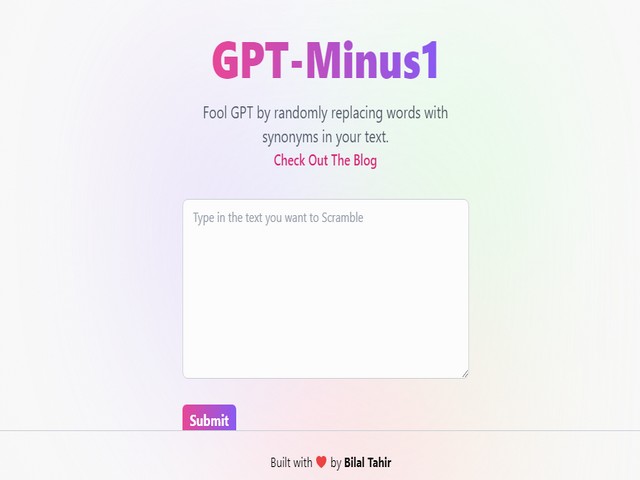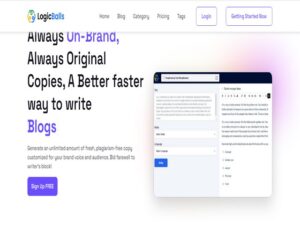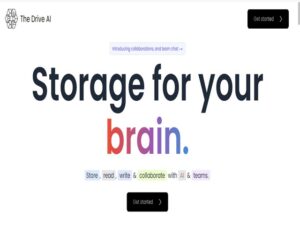Exploring the Power of GPT MINUS 1: Unraveling the Potential of Advanced Text Generation
“Exploring the Power of GPT MINUS 1: Unraveling the Potential of Advanced Text Generation” looks at an intriguing AI tool. Assume you have a super-smart writing assistance dubbed GPT, which stands for “Generative Pre-trained Transformer.” It’s like a magician creating text depending on what it learns from massive amounts of data.
Think of GPT MINUS 1 as a close relative of GPT, but with a twist. It can also create text, but it’s like GPT’s younger sister, still learning the ropes. Despite being less evolved, it has its own appeal and promise.
This page discusses how it works, where it could be effective, and the obstacles it confronts. So let’s go on a voyage to discover the wonder of it and how it could influence our future experiences with AI-generated material!
Introduction to GPT MINUS 1
GPT MINUS 1 is an amazing variation on the advanced text generation model known as GPT (Generative Pre-trained Transformer). While GPT is well-known for its capacity to create text from massive volumes of data, GPT MINUS 1 works in a similar manner but with one little distinction. It’s like GPT’s junior counterpart, still learning and honing its talents. Despite being a less complex version, it shows potential in a variety of applications that need text production. This introduction offers the basis for exploring the capabilities, prospective applications, and limitations connected with this new AI tool.
Understanding Text Generation with GPT Models
language creation using GPT models is an interesting technique in which artificial intelligence (AI) systems generate humanlike language based on patterns learned from massive training datasets. GPT, which stands for Generative Pretrained Transformer, is at the forefront of this technology.
It uses a transformer architecture to analyze and create text with exceptional flow and consistency. At its basic level, GPT operates by predicting the next word in a series based on the previous context. This predictive capacity comes from its pretraining phase, in which it learns from massive volumes of text data, learning the complex details of language structure, syntax, and semantics.
When prompted to generate text, GPT models use their previously learned information to deliver logical and contextually relevant replies. GPT excels in mimicking human-like writing, whether it’s completing phrases, composing paragraphs, or even crafting full essays.
However, it is critical to understand that GPT’s output is not perfect. While it frequently produces excellent results, there may be instances of mistakes, repetition, or even nonsensical information, particularly when prompted with unclear or unfamiliar situations.
Despite these limits, GPT models’ capabilities are fast evolving, bringing up plenty of new opportunities in a variety of sectors such as content generation, customer support, and creative writing. Understanding the complexities of text creation using GPT models offers the groundwork for maximizing their potential while navigating their unique characteristics successfully.
Exploring the Concept of GPT MINUS 1
it adds an interesting touch to the field of text production. Consider the original GPT model to be a seasoned writer with years of expertise who effortlessly produces excellent language. Consider GPT MINUS 1 to be a new writer, eager to learn and grow while still honing their craft. The idea underlying it is simple but deep. It functions on the same principles as its predecessor, GPT, but with much reduced capabilities. While it lacks the complicated nature of GPT, it retains the basic capacity to create text based on patterns learned from substantial training data.
This reduction creates a unique dynamic. it may create less polished or refined writing than GPT, but it does provide a distinct viewpoint. Its output may include oddities or faults that lend character and authenticity to the created text. Understanding the merits and limits of it’s essential while exploring the topic. While it may not shine in every setting, there are some situations in which its less polished output may be beneficial. Also, examining it explains the inner workings of text generation models and gives insights into how AI systems learn and grow over time.
In simple terms, studying the idea of GPT MINUS 1 is an exercise in understanding the complex nature of text production and recognizing the breadth of AI models accessible. By embracing its unique features, we can discover new possibilities for creative expression and innovation in the field of AI.
Applications and Use Cases
It’s applications and use cases cover several areas, utilizing its text production skills for a variety of purposes:
- Content Creation: it can help content authors by creating drafts, generating concepts, and offering alternate viewpoints. It is especially useful for creating blog entries, social media captions, and product descriptions.
- Creative Writing: It may help writers and authors overcome writer’s block, experiment with fresh story concepts, and produce character dialogue. It may be an effective technique for creating suggestions for narrative or poetry.
- Language Learning: It may help language learners by creating example sentences, quizzes, and interactive activities. It can give specific feedback on language usage while also teaching vocabulary and grammatical principles.
- Customer Service: It may be utilized by chatbots or virtual assistants to answer customer questions, promote products, and provide technical assistance. The capacity to produce natural-sounding replies improves the user experience during customer support experiences.
- Educational Content: It allows teachers and educators to create learning materials, quiz questions, and interactive courses. It can adjust information to different learning styles and provide learners with specific feedback.
- Research and Analysis: Researchers may use GPT MINUS 1 to analyze huge quantities of text data, summarize research papers, and formulate hypotheses based on existing literature. Its text-generating skills speed up the process of obtaining insights from textual sources.
- Marketing and Advertising: GPT MINUS 1 may help marketers generate ad text, create email campaigns, and personalize marketing messaging. It may tailor information to specific demographics and maximize interaction across several platforms.
- Entertainment and Gaming: It can be used in interactive storytelling platforms, roleplaying games, and narrative-based experiences.
To increase player immersion, it may dynamically produce story twists, character dialogue, and world-building features. These examples demonstrate it’s adaptability and promise to enhance human creativity and productivity across a variety of sectors and use cases. Organizations and individuals can open up possibilities for creativity and efficiency by utilizing text creation skills.
Limitations and Challenges
While it offers exciting possibilities in text generation, it also comes with its own set of limitations and challenges:
Quality of Output: It may produce text that is less coherent or accurate compared to its more advanced counterparts. Its output may contain grammatical errors, inconsistencies, or irrelevant information, particularly in complex or ambiguous contexts.
Bias and Inaccuracy: Like other AI models, it may inherit biases present in the training data, leading to the generation of biased or insensitive content. Additionally, it may struggle with factual accuracy, potentially propagating misinformation or generating misleading information.
Lack of Contextual Understanding: it may struggle to grasp nuanced contexts or understand subtle nuances in language. This can result in the generation of responses that are contextually inappropriate or miss the intended meaning of the input.
Limited Creativity: While it is capable of generating text based on learned patterns, it may lack the creativity and originality exhibited by human writers. Its output may feel formulaic or predictable, lacking the spontaneity and imagination of human-generated content.
Over-reliance on Training Data: It relies heavily on the quality and diversity of its training data. Biases, inaccuracies, or limitations present in the training data can directly impact the quality of its output, leading to suboptimal performance in certain scenarios.
Ethical and Legal Concerns: The use of AI models like it raises ethical and legal considerations regarding ownership of generated content, accountability for potential harms caused by misinformation, and privacy implications related to the use of personal data.
Computational Resources: Training and fine-tuning GPT MINUS 1 models require significant computational resources and expertise. Access to high-performance computing infrastructure and data science skills may pose barriers to adoption for some organizations and individuals.
Continual Improvement: It requires ongoing monitoring, evaluation, and refinement to address its limitations and improve its performance over time. This iterative process of model development and optimization demands resources and expertise from developers and researchers.
Addressing these limitations and challenges is essential for realizing the full potential of GPT MINUS 1 and ensuring its responsible and ethical use in various applications. By actively mitigating risks and enhancing capabilities, developers and users can leverage it effectively while minimizing potential negative impacts.
Future Directions and Implications
Future Directions and Implications of GPT MINUS 1
1. Enhanced Text Generation Capabilities: Future advancements in AI research and technology may lead to improvements in the text generation capabilities of GPT MINUS 1. This includes enhancing its ability to understand context, generate more coherent and contextually relevant responses, and reduce biases in its output.
2. Integration with Multimodal Inputs: GPT MINUS 1 could evolve to support multimodal inputs, incorporating not only text but also images, audio, and video. This would enable more diverse and interactive forms of content generation, opening up new possibilities for creative expression and communication.
3. Personalization and Adaptation: GPT MINUS 1 may become increasingly adept at personalizing its output based on user preferences, writing style, or domain-specific knowledge. This could lead to more tailored and customized text generation experiences, catering to individual needs and preferences.
4. Ethical and Responsible AI Development: As AI technologies like GPT MINUS 1 continue to evolve, there will be a growing emphasis on ethical and responsible AI development practices. This includes addressing biases, ensuring transparency and accountability, and safeguarding against potential misuse or harmful impacts.
5. Collaborative Human-AI Interaction: GPT MINUS 1 may facilitate collaborative interactions between humans and AI systems, where humans provide guidance, feedback, and oversight to AI-generated content. This collaborative approach can leverage the strengths of both humans and AI, fostering creativity, productivity, and innovation.
6. Domain-Specific Applications: GPT MINUS 1 could be adapted and fine-tuned for specific domains or industries, such as healthcare, finance, or legal services. Tailoring its capabilities to address domain-specific challenges and requirements could unlock new opportunities for automation and efficiency.
7. Regulatory and Policy Considerations: The widespread adoption of AI technologies like GPT MINUS 1 will necessitate the development of regulatory frameworks and policies to ensure responsible and ethical use. This includes guidelines for data privacy, intellectual property rights, and accountability for AI-generated content.
8. Impact on Employment and Workforce: The integration of AI technologies like GPT MINUS 1 into various industries may have implications for employment and the workforce. While AI can automate repetitive tasks and enhance productivity, it may also require reskilling and upskilling workers to adapt to changing job roles and responsibilities.
Exploring these future directions and implications provides valuable insights into the evolving landscape of AI-driven text generation and its potential impact on society, economy, and human-AI interactions. By proactively addressing challenges and opportunities, stakeholders can shape the responsible and beneficial integration of GPT MINUS 1 and similar AI technologies into our daily lives.
Conclusion: Harnessing the Potential of GPT MINUS 1
GPT MINUS 1 represents a fascinating development in the field of text generation, offering a unique blend of capabilities and challenges. As we conclude our exploration of this innovative AI tool, it’s clear that GPT MINUS 1 holds significant potential for various applications across industries and domains.
While GPT MINUS 1 may not match the sophistication of its more advanced counterparts, it offers valuable insights into the inner workings of AI models and the complexities of language generation. Its ability to generate text based on learned patterns opens up opportunities for creativity, productivity, and innovation.
However, realizing the full potential of GPT MINUS 1 requires a concerted effort to address its limitations and challenges. This includes mitigating biases, enhancing accuracy and coherence, and fostering responsible and ethical AI development practices.
By harnessing the potential of GPT MINUS 1 effectively, we can unlock new possibilities for content creation, communication, and collaboration. Whether assisting writers, supporting language learners, or enhancing customer interactions, GPT MINUS 1 has the power to augment human capabilities and streamline processes in diverse contexts.
As we move forward, it’s essential to approach the integration of GPT MINUS 1 and similar AI technologies with careful consideration and foresight. By fostering collaboration between humans and AI systems, prioritizing ethical and responsible AI development, and embracing continuous improvement and innovation, we can harness the full potential of GPT MINUS 1 to shape a more efficient, creative, and inclusive future.



